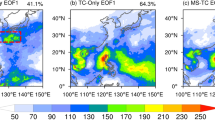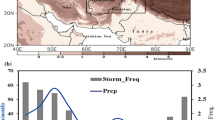Abstract
In this study, an attempt has been made to examine the relationship between summer monsoon rainfall (June–September) and the total number of depressions, cyclones and severe cyclones (TNDC) over Bay of Bengal during the post-monsoon (October–December) season. The seasonal rainfall of the subdivisions (located in south India) (referred as rainfall index – RI), is positively and significantly correlated (r=0.59; significant at >99% level) with the TNDC during the period, 1984–2013. By using the first differences (current season minus previous season), the correlations are enhanced and a remarkably high correlation of 0.87 is observed between TNDC and RI for the recent period, 1993–2013. The average seasonal genesis potential parameter (GPP) showed a very high correlation of 0.84 with the TNDC. A very high correlation of 0.83 is observed between GPP and RI for the period, 1993–2013. The relative vorticity and mid-tropospheric relative humidity are found to be the dominant terms in GPP. The GPP was 3.5 times higher in above (below) normal RI in which TNDC was 4 (2). It is inferred that RI is playing a key role in TNDC by modulating the environmental conditions (low level vorticity and relative humidity) over Bay of Bengal during post-monsoon season which could be seen from the very high correlation of 0.87 (which explains 76% variability in TNDC). For the first time, we show that RI is a precursor for the TNDC over Bay of Bengal during post-monsoon season. Strong westerlies after the SW monsoon season transport moisture over the subdivisions towards Bay of Bengal due to cyclonic circulation. This circulation favours upward motion and hence transport moisture vertically to mid-troposphere which causes convective instability and this in turn favour more number of TNDC, under above-normal RI year.





Similar content being viewed by others
References
Ashok K and Guan Z 2004 Individual and combined influences of ENSO and the Indian Ocean Dipole on the Indian summer monsoon; J. Climate 17 3141–3155.
Balachandran S and Geetha B 2012 Statistical prediction of seasonal cyclone activity over north Indian Ocean; Mausam 63 17–28.
Camargo S J, Emanuel K A and Sabel A H 2007 Use of a genesis potential index to diagnose ENSO effects on tropical cyclone genesis; J. Climate 20 4819–4834.
De Maria M, Knaff J A and Bernadette H C 2001 A tropical cyclone genesis parameter for the tropical Atlantic ; Wea. Forecasting 16 219–233.
Emanuel K A and Noolan D S 2004 Tropical cyclone activity over global climate; Proc. 26th Conference on Hurricane and Tropical Meteorology; FL, Miami.
Felton C S, Subrahmanyam B and Murty V S N 2013 ENSO-modulated cyclogenesis over the Bay of Bengal ; J. Climate 26 9806–9818.
Girishkumar M S and Ravichandran M 2012 The influences of ENSO on tropical cyclone activity in the Bay of Bengal during October–December; Geophys. Res. Lett. 117 C02033. doi:10.1029/2011JC007417.
Gray W M 1975 Tropical cyclone genesis: Dept. Atmos. Sci., paper 232, Colorado State University, Port Collins, Co, USA, 121p.
Kalnay et al. 1996 NCEP/NCAR 40 year reanalysis project; Bull. Am. Metor. Soc. 77 437–470.
Kikuchi K and Wang B 2010 Formation of tropical cyclones in the northern Indian Ocean associated with two types of tropical intra seasonal oscillation modes; J. Meteor. Soc. Japan 88 475–496.
Kotal S D, Kundu P K and Roy Bhowmik S K 2009 Analysis of cyclogenesis parameter for developing and nondeveloping low pressure systems over the India sea; Nat. Hazards 50 389–402.
Kumar V and Krishnan R 2005 On the association between the Indian summer monsoon and the tropical cyclone activity over northwest Pacific; Curr. Sci. 88 602– 612.
Li Z, Li T, Yu W, Li K and Liu Y 2015 What controls the inter annual variation of tropical cyclone frequency over Bay of Bengal in the peak post-monsoon season?; Atmos. Sci. Lett. doi:10.1002/asl.636..
Mc Bride J L and Zehr R M 1981 Observational analysis of tropical cyclone formation. Part II: Comparison of nondeveloping versus developing systems; J. Atmos. Sci. 38 1132–1151.
Murakami H, Wang B and Kitoh A 2011 Future change of western north Pacific typhoons: Projections by a 20-km mesh global atmospheric model; J. Climate 20 4819–4834.
Nicholls N 1984 The southern oscillation, sea surface temperature and inter annual fluctuations in Australian seasonal cyclone activity; J. Climatol. 4 661–670.
Nicholls N 1992 Recent performance of a method for forecasting Australian seasonal tropical cyclone activity; Aust. Met. Mag. 40 105–110.
Revell C G and Goulter S W 1986 Lagged relationships between the southern oscillation and numbers of tropical cyclones in the southern pacific region; Mon. Wea. Rev. 114 2669–2670.
Roy Bhowmik 2003 An evalution of cyclone genesis parameter over the Bay of Bengal using model analysis; Mausam 54 355–358.
Royer J F, Chauvin F, Timbal B, Araspin P and Grimal D 1998 A GCM study of the impact of greenhouse gas increase in the frequency of occurrence of tropical cyclones; Clim. Change 38 307–343.
Sadhuram Y 2016 Can we predict the frequency of cyclones over Bay of Bengal during October–December?; Mausam (in press).
Singh O P 2008 Indian ocean dipole mode and tropical cyclone frequency; Curr. Sci. 94 29–31.
Sumesh K and Ramesh Kumar M R 2013 Tropical cyclones over north Indian Ocean during El Nino Modoki years; Nat. Hazards 68 1057–1074.
Tsuboi A and Takemi T 2014 The inter-annual relationship between MJO activity and tropical cyclone genesis in the Indian Ocean; Geosci. Lett. 19. doi:10.1186/2196-4092-1-9.
Acknowledgements
The authors would like to thank Dr S W A Naqvi, Director, CSIR–NIO, Goa and Dr V S N Murty, Scientist-in-Charge, CSIR–NIO Regional Centre, Visakhapatnam, for the support and encouragement. Senior author, Y Sadhuram would like to thank CSIR, New Delhi, for providing the Emeritus Scientist scheme. Thanks to the project teams of NOAA, IITM and IMD for making the datasets available on their websites. The authors would like to thank both the reviewers for their valuable suggestions which helped to improve the original version of the manuscript. NIO contribution number 5918.
Author information
Authors and Affiliations
Corresponding author
Additional information
Corresponding editor: A K Sahai
Rights and permissions
About this article
Cite this article
SADHURAM, Y., MANEESHA, K. Relationship between summer monsoon rainfall and cyclogenesis over Bay of Bengal during post-monsoon (October–December) season. J Earth Syst Sci 125, 1473–1479 (2016). https://doi.org/10.1007/s12040-016-0734-6
Received:
Revised:
Accepted:
Published:
Issue Date:
DOI: https://doi.org/10.1007/s12040-016-0734-6




